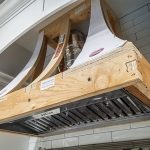Yes, range hoods require gfci protection for safety reasons. Range hoods need to be connected to a gfci outlet to prevent electric shocks and comply with electrical codes.
Not only does this protect you from potential electrical hazards, but it also ensures your range hood functions properly. Without gfci protection, there is a higher risk of electrical faults and malfunctions. Additionally, a range hood in a damp or wet area, such as above a sink, requires gfci protection to meet safety standards.
Therefore, it is crucial to install a gfci outlet or use a gfci breaker when connecting a range hood to the electrical supply.

Credit: www.qualifiedremodeler.com
Importance Of Gfci Protection For Range Hoods
Range hoods are an essential feature of any kitchen, effectively removing smoke, odors, and grease from the air. However, when it comes to ensuring the safety of these appliances, it is crucial to consider the installation of ground fault circuit interrupter (gfci) protection.
In this section, we will explore the importance of gfci protection for range hoods, understanding its role in preventing electrical accidents, exploring potential hazards associated with range hoods, and highlighting the benefits of implementing gfci protection in range hood installations.
Understanding The Role Of Gfci Protection In Preventing Electrical Accidents
- Gfci protection acts as a safety mechanism that quickly shuts off the circuit when it detects an imbalance in electrical current.
- By rapidly interrupting the flow of electricity, gfci protection helps prevent electrical shocks and potential fires.
- It provides an additional layer of safety, specifically crucial in areas where water and electrical appliances come into contact, such as kitchens.
Exploring The Potential Hazards Associated With Range Hoods
- Range hoods are typically located above cooktops or stoves, which means they are prone to exposure to heat, steam, and grease.
- This combination of factors increases the risk of electrical short circuits and potential electrical fires.
- Without gfci protection, these hazards can put homeowners at risk of electrical shock, property damage, and even life-threatening accidents.
Highlighting The Benefits Of Implementing Gfci Protection In Range Hood Installations
- Gfci protection offers immediate detection and shut-off of electrical faults, minimizing the risk of electrical accidents.
- By installing gfci protection for range hoods, homeowners can have peace of mind knowing that their appliances meet modern safety standards.
- It is a cost-effective safety measure that can prevent costly repairs, property damage, and potential injuries.
Gfci protection plays a crucial role in ensuring the safety of range hood installations. By swiftly detecting electrical imbalances and interrupting the circuit, it provides an additional layer of protection against electrical accidents. Considering the potential hazards associated with range hoods, implementing gfci protection is an essential step in safeguarding your home and loved ones.
Electrical Standards And Requirements For Range Hoods
Range hoods are an essential component of any kitchen, playing a vital role in ensuring a clean and safe cooking environment. However, when it comes to electrical installations, it’s crucial to be aware of the relevant codes and regulations to ensure compliance and safety.
In this section, we will familiarize ourselves with the electrical standards and requirements for range hoods, with a specific focus on the need for gfci protection.
Familiarizing With The Relevant Electrical Codes And Regulations:
- The national electrical code (nec) sets the standard for electrical installations in the united states and provides guidelines for range hood installations.
- The nec considers range hoods as fixed appliances and provides specific requirements for their electrical connections.
- Local building codes may have additional regulations or modifications, so it’s important to check with your local authorities before installing a range hood.
Analyzing The Specific Requirements For Gfci Protection In Range Hood Installations:
- Gfci (ground fault circuit interrupter) protection is an important safety feature that helps prevent electrical shocks and fires.
- The nec requires gfci protection for receptacles installed in specific areas, such as within six feet of a sink or in the presence of moisture.
- Range hood receptacles may be subject to gfci protection requirements depending on their location within the kitchen.
Explaining The Importance Of Compliance With Electrical Standards For Safety:
- Compliance with electrical standards and requirements ensures the safety of your range hood installation.
- Failure to adhere to these standards may result in electrical hazards, such as shocks, short circuits, or fires.
- Additionally, non-compliance can lead to violations during home inspections or insurance claims, potentially impacting your home’s value or coverage.
By understanding and adhering to the electrical codes and regulations for range hoods, you can ensure the safe and efficient operation of your kitchen ventilation system. Remember to consult a qualified electrician or follow the manufacturer’s instructions for proper installation and to further guarantee compliance with these standards.
Factors To Consider When Determining Gfci Protection For Range Hoods
Range hoods are an essential component of any kitchen, ensuring ventilation and removing smoke, odors, and grease. But when it comes to safety, it’s important to consider whether a range hood requires gfci (ground fault circuit interrupter) protection. Gfci protection is designed to detect electrical imbalances and quickly cut off power to prevent electrical shock.
In this blog post, we’ll examine the factors to consider when determining gfci protection for range hoods.
Examining The Location And Proximity Of The Range Hood To Water Sources:
- If the range hood is located near water sources, such as sinks or faucets, gfci protection is highly recommended to minimize the risk of electrical shock.
- Water can easily splash or spill onto the range hood, increasing the potential for electrical hazards.
- Even if the range hood is not located directly above water sources, it’s still important to evaluate the proximity and potential for water exposure.
Discussing The Installation Method And Requirements For Gfci Protection:
- Proper installation is crucial for gfci protection. The range hood should be correctly connected to a gfci-protected circuit.
- Gfci outlets are typically required in kitchens, especially near sinks and other water sources. Ensure that the range hood is connected to one of these outlets for optimal safety.
- If a gfci outlet is not conveniently located, an electrician can install a gfci circuit breaker to provide the necessary protection.
Considering The Types Of Range Hood Motors And Their Impact On Gfci Protection Needs:
- The type of motor used in the range hood can impact the gfci protection requirements.
- Some range hoods have motors that are more prone to tripping gfci devices due to electrical noise or fluctuations.
- In such cases, it may be necessary to use a dedicated circuit with gfci protection to avoid nuisance tripping and ensure the continuous operation of the range hood.
By evaluating these factors, you can determine whether gfci protection is necessary for your range hood. Prioritizing safety and adhering to electrical codes and guidelines will help ensure a secure and functional kitchen environment.
Choosing The Right Gfci Protection For Range Hood Installations
Does range hood require gfci: choosing the right gfci protection for range hood installations
Are you considering installing a range hood in your kitchen? If so, you might be wondering if a range hood requires gfci protection. We will explore the different types of gfci devices available in the market, evaluate their pros and cons in relation to range hood installations, and provide recommendations for selecting the most suitable gfci protection option.
Exploring The Different Types Of Gfci Devices Available In The Market
Gfci devices come in various types, each offering unique features and benefits. Understanding these options can help you make an informed decision when it comes to protecting your range hood. Here are a few types worth considering:
- Gfci outlets: These devices have integrated gfci protection and can be installed in place of standard electrical outlets. They provide convenience and eliminate the need for additional gfci devices.
- Gfci circuit breakers: Installed in the main electrical panel, these circuit breakers provide gfci protection for all outlets on a specific circuit. They offer a centralized solution but may require professional installation.
- Gfci receptacles: These devices replace traditional electrical outlets and provide gfci protection. They are a cost-effective option for protecting individual outlets throughout your kitchen.
Evaluating The Pros And Cons Of Each Type In Relation To Range Hood Installations
Each type of gfci protection has its own advantages and considerations when it comes to range hood installations. Let’s take a closer look:
- Gfci outlets:
- Pros: Easy to install, available in various configurations, and provide gfci protection in a single device.
- Cons: Limited to specific locations where outlets are present, may require wiring modifications.
- Gfci circuit breakers:
- Pros: Centralized protection for multiple outlets, no need for individual gfci devices, and can provide protection to other electrical devices on the circuit.
- Cons: Professional installation required, higher cost compared to individual gfci outlets.
- Gfci receptacles:
- Pros: Cost-effective, easy to install, and can be added to specific locations without modifying the entire circuit.
- Cons: May require multiple gfci devices throughout the kitchen, requires more planning to ensure complete coverage.
Providing Recommendations For Selecting The Most Suitable Gfci Protection Option
When choosing the most suitable gfci protection option for your range hood installation, consider the following recommendations:
- Assess the electrical setup in your kitchen and determine the locations where gfci protection is necessary.
- Consider the convenience and ease of installation offered by different types of gfci devices.
- Evaluate the overall cost implications, including installation expenses and the number of devices required.
- Consult with a qualified electrician to ensure compliance with local electrical codes and regulations.
Remember, safety should always be a priority when working with electrical installations. By selecting the right gfci protection option for your range hood, you can ensure a secure and efficient kitchen environment.
Installation Tips And Best Practices For Gfci Protection In Range Hoods
Outlining The Step-By-Step Process For Installing Gfci Protection:
- Begin by ensuring that the power to the range hood is turned off before starting the installation process.
- Locate the circuit breaker or fuse that controls the power to the range hood and switch it off.
- Identify the electrical junction box where the range hood will be installed.
- Use a voltage tester to double-check that there is no power running to the junction box.
- Install the gfci outlet into the junction box, following the manufacturer’s instructions.
- Connect the wiring to the gfci outlet, making sure to match the corresponding wires.
- Secure the outlet to the junction box and tighten any screws or fasteners.
- Once the gfci outlet is properly installed, turn the power back on at the circuit breaker or fuse box.
- Test the gfci protection by pressing the “test” button on the outlet. The power to the range hood should immediately be cut off.
- Finally, press the “reset” button on the outlet to restore power to the range hood.
Highlighting The Common Mistakes To Avoid During Installation:
- Neglecting to turn off the power before starting the installation can result in serious electric shock or injury. Always verify that the power is switched off before beginning any electrical work.
- Failing to properly connect the wiring can lead to unreliable gfci protection or even electrical fires. Take the time to carefully match the wires and ensure a secure connection.
- Overlooking the importance of testing the gfci outlet after installation can leave you unaware of potential faults or malfunctions. Always perform the necessary tests to confirm proper functioning.
- Neglecting to properly screw in or secure the gfci outlet can lead to loose connections or instability. Make sure that the outlet is securely fastened to the junction box.
- Ignoring the need for regular maintenance and testing of the gfci outlet can render the protection ineffective over time. It is crucial to periodically test the outlet and replace it if necessary to ensure continued safety.
Providing Tips For Ongoing Maintenance And Testing Of Gfci Protection:
- Regularly test the gfci outlet by pressing the “test” button to ensure it is functioning properly. The power should immediately cut off when tested.
- Reset the gfci outlet by pressing the “reset” button after each test to restore power to the range hood.
- Inspect the outlet for signs of damage or wear, such as cracked casing or loose connections, and replace it if necessary.
- Keep the gfci outlet clean and free from dust or debris that could interfere with its operation.
- If you experience any issues with the gfci protection, such as frequent tripping or failure to reset, consult a professional electrician for further inspection and repair.
- Educate yourself and your household members on the importance of gfci protection and how to test and reset the outlet correctly.
Remember, the proper installation and maintenance of gfci protection in range hoods is crucial for electrical safety in your kitchen. By following these installation tips, avoiding common mistakes, and conducting regular tests and maintenance, you can ensure the effectiveness of your gfci protection and maintain a safe cooking environment.
Frequently Asked Questions Of Does Range Hood Require Gfci
Is A Gfci Required For A Range Hood?
Yes, it is highly recommended to have a gfci (ground fault circuit interrupter) for your range hood. This electrical safety device protects against electrical shocks and can save lives by quickly shutting off power in the event of a ground fault.
What Is The Purpose Of A Gfci For A Range Hood?
A gfci is designed to detect any imbalance in electrical current, preventing potential electrical hazards. In the case of a range hood, a gfci can safeguard against shocks and fires, ensuring the safety of the appliance and anyone using it.
Can A Range Hood Be Connected To A Non-Gfci Outlet?
While it is technically possible to connect a range hood to a non-gfci outlet, it is not recommended. Using a gfci outlet enhances safety by providing additional protection against electrical faults, minimizing the risk of electrical accidents associated with range hood operation.
Should A Range Hood Be On A Dedicated Circuit With Gfci?
It is advisable to have a range hood on a dedicated circuit to ensure proper electrical supply and minimize potential issues. Additionally, incorporating a gfci into this dedicated circuit will provide an extra layer of electrical safety.
Do All Range Hoods Come With A Built-In Gfci?
No, not all range hoods come with a built-in gfci. Some range hoods may require a separate gfci outlet or breaker installation. It’s important to check the manufacturer’s specifications or consult with an electrician to ensure proper gfci protection for your specific range hood model.
Conclusion
Range hoods are an essential component of any kitchen, helping to eliminate smoke, odors, and grease. Throughout this blog post, we have explored the question of whether range hoods require gfci (ground fault circuit interrupter) protection. In many cases, the answer is yes.
Gfci protection can help prevent electrocution and reduce the risk of electrical shock when using a range hood. By installing a gfci outlet or circuit breaker, you can ensure that your range hood is protected against potential electrical hazards. It is important to remember that building codes and regulations may vary, so it is always best to consult with a qualified electrician or local authority.
By adhering to the necessary safety precautions and requirements, you can enjoy the benefits of a range hood in your kitchen without compromising on safety. So, when it comes to range hoods, it’s better to be safe than sorry!

Freda is a passionate foodie and kitchen gadget enthusiast. With over 10 years of experience in the culinary industry, Freda brings her expertise in testing and reviewing kitchen gadgets.





